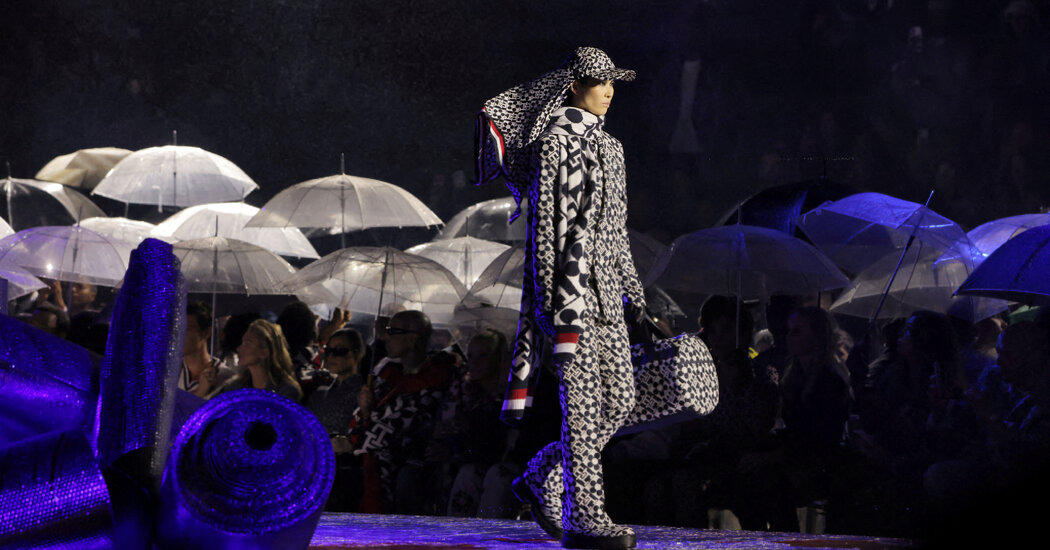
It was raining on Tommy Hilfiger’s runway parade.
The designer had come back to New York Fashion Week with his signature see now/buy now preppy cosplay after a few years away and with a special “Tommy Factory” extravaganza modeled on Andy Warhol’s Factory. (The two men met in the 1980s, and, Mr. Hilfiger said in a preview, he had been inspired by Warhol ever since.)
He had covered an outdoor catwalk in what looked like silver tinfoil à la Warhol for his set, reached through a silver-covered courtyard where artists were silk-screening posters of Mr. Hilfiger’s face behind a camera, like one of Warhol’s self-portraits. And he invited a soup of famous folk, many of whom feature in the new Hilfiger ad campaign, to sit front row: Kate Moss, Jon Batiste, Shawn Mendes, John Legend. He had a charming collaboration with the cool British designer Richard Quinn on the runway, as well as the former Warhol “tape recorder” Bob Colacello. He even had Travis Barker to drum the finale. But he didn’t have a tent, and it was bucketing down.
Not even the biggest stars could stop the result from looking like a damp squib: an empty shell of clichéd American references (the varsity jacket! the rugby shirt! the tennis sweater!) in a world that doesn’t have much truck with them any more, covered in razzmatazz that got washed away by the weather. Underneath, there wasn’t much substance. And substance is what New York fashion really needs.
As with so much right now, there is a divide opening up between what was and what might be.
Many of the names that once defined the city’s style are gone — or at least off the official runway: Calvin, Donna, Ralph, Marc. The generations of designers that came after and were heralded as the Next Big Thing seem stuck in a very minor key.
At Proenza Schouler, Lazaro Hernandez and Jack McCollough added giant flamenco ruffles to the sleeves of their tunics and minidresses. They upsized the flares of their skinny pants; rendered shirtdresses in sheer lace with fluted cuffs, and layered on the polka dots. But they still look as if they are designing for the Chelsea art crowd, when the art crowd has moved on. Jason Wu continues to make Daisy Buchanan cocktail dresses in bias, fringe and crystal mesh for the Stork Club of the mind, all beautifully generic. Joseph Altuzarra has settled into a rhythm of anoraks, striped shirting and highly detailed, increasingly complex shibori, which makes for a cool, if predictable, contrast.
At least they didn’t entirely lose their way like Prabal Gurung, who went on a ill-conceived detour into peekaboo, latex and lace that involved sheer pants, corsetry only sort of covered in acres of tulle, and, at one point, the mistakenly exposed breast of Ella Emhoff, the second stepdaughter. Show notes that framed the whole thing as a reaction to the “patriarchy” and “regressive values” did not help it make sense.
(Sergio Hudson also took an unfortunate turn into sexiness, subverting his superwoman tailoring with an overdose of boobs ’n’ bombshell.)
Yet at the same time, new names are muscling in from the edges, often without classical training but with the self-belief and explosive energy that has historically propelled fashion forward.
They have little to do with Seventh Avenue and lots to do with the communities whence they spring. Their origin stories often have to do with making clothes for their friends, not department stores. Their audiences are often filled with the like-minded, who clog the streets beforehand like groupies. You can tell because at least half of the attendees are wearing the clothes of the designers they have come to see — not as paid ambassadors or influencers, but as genuine converts. Their friends often model in their shows.
And those designers are redefining power dressing not as a uniform for climbing the corporate ladder (what is that now, anyway, in the time of the disappearing office?) but as a uniform of identity for a mosaic of subcultures.
Andrew Bolton of the Costume Institute at the Met picked up on it in the contemporary section of his show on American fashion, and it’s playing out on the runways.
In the work of designers like Hillary Taymour of Collina Strada, whose earth-first collection of ginormous flower-power cargo pants, shrunken T-shirts and deconstructed court dress (panniers, corsets, trains) recycles and remixes not just materials but also historical moments and even vegetables (broccoli purse, anyone?) and seems increasingly prescient rather than fringe.
Also, Mike Eckhaus and Zoe Latta of Eckhaus Latta, whose clothes are the fashion equivalent of collectible ceramics. They combine high craft and tactility with a raised eyebrow and included stretchy rib knits printed with the work of the painter Matthew Underwood, squishy bubble tops that foamed over the torso, metallic T-shirts and some unexpectedly bared limbs, including a pair of one-legged pants.
Both labels started as quasi-art projects but have grown into increasingly solid businesses, which also seems to be the direction of Puppets and Puppets, the line by the mixed media artist Carly Marks. This season she mixed bumster dresses, lace bodysuits and trompe l’oeil bodysuit leathers with simple zip-front sheaths, a little crystal cardigan and skirt set, and the snack-food-bedecked handbags that are already a signature.
And also, Everard Best and Téla D’Amore of Who Decides War, a brand built on the idea of denim as the universal American religion, and jeans in all their iterations — frayed, embroidered, patched, painted, inset with stained glass portraits, speckled with rhinestones like water droplets, overlaid with lace like a baptismal gown, infused with references to climate change, colonialism and even Serena Williams — as a gospel. It’s written on the fabric, and in the seams.
The result, extended to sweatshirts with stained glass windows cut into the body and a few dresses with the same complex surface treatments, may be the closest thing this country has to truly original American couture.






